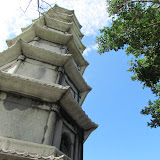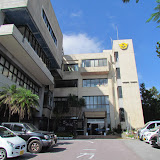 |
| Inscription to the missing 'Esu Shirube Stone' |
GPS
| Latitude | Longitude |
| N 26 20.913 | E 127 50.123 |
The Mysterious 'Esu Shirube Stone'
Update: November 2, 2012. Last week the, Esu Shirube Stone was discovered. Overgrown vegetation in the immediate area was removed and the stone can now be seen. It is a small stone roughly 12 inches in height. Pictures were not taken due to inclement weather, but will be uploaded once available. A picture of another Shirube-like Stone surfaced in Nago City and its location is currently being researched.
There are many sites I have found on Okinawa by accident. The 'Esu Shirube Stone' is no exception. Well... actually I didn't find the 'Esu Shirube Stone'...but maybe its former resting place. And the only reason I found it was because I was first attracted to an Utaki (sacred place of prayer) with a prominent tree in front of it (see photo album, last picture). To my chagrin, there was nothing describing or explaining the origin of this Utaki. Disappointed, I returned to my car. That's when I noticed some log steps leading up to a small elevated mound, and there it was...a two-foot tall stone inscription. But was this the stone itself? Or just an inscription of the actual 'Esu Shirube Stone'? I believe it to be the latter (there was another set of log steps leading behind the inscription and what seems to be remnants of a foundation). So where did this missing Stone go? I'm afraid I have more questions than answers about this historical relic. Hopefully someone out there reading this post may know the answer.
But we do have some clues. For starters, Esu is a district in Uruma City. Second, the inscription left behind was half written in Japanese and the other half in English. The English heading clearly says 'Esu Shirube Stone'. However, due to years of erosion, portions of the translation were not legible. Below is the best I could make out and hopefully it will give us more clues. The pound sign '#' denotes characters that I could not decipher.
Esu Shirube Stone
The Shuri Government ####unded 2### - 300 Shirube Stones in each town of Okinawa during 1737 to 1750. Shirube Stones was a da #um## ### ##easure land in those days but nowadays ### of #hem has been disappeared.
### Shirube Stones is one #### ### has been (rest was not legible).
So couple of questions come into mind.
Question 1. What exactly is the 'Esu Shirube Stone'? A Google Search (in English) gave me negligible results. I have asked various elders and locals about the word 'Shirube' and it was unknown to them. When I checked an online Japanese dictionary, It did list 'Shirube' as a 'family name'. However, the Kanji they used and the ones on the inscription did not seem to match. Furthermore, the word 'Shirube' was not written in Katakana which suggest it may not even be a Hogen word.
Question 2. Where are the other stones?
Question 3. Where exactly is the current Esu Shirube Stone? Obviously it must have been intentionally relocated.
Question 3 should be relatively easy to find since I am sure all historical artifacts and locations that were given an inscription on location must also have been documented and filed at the City Office. However, as easy as that sounds, that too can be weeks or months of research. I am sure someone knows the answer.
Your guess is good as mine on what the actual translation is supposed to say. It does spark some interest though. One word almost looks like it is supposed to be the word 'treasure'. The number of missing characters in the translation may not be accurate as well. It was difficult to tell if there was supposed to be a character or space in between. I posted this blog because I hope maybe someone out there knows something about this stone or has seen a similar stone in their area. Someone out there knows. Until then, this relic is another one for the Okinawa X-Files.
Getting there. This location is close to the Highway 85 and 224 intersection and right across from the Make-Man hardware store (see land mark on the map). There is also a small tunnel along the 224. The 'Esu Shirube Stone' sits approximately over this tunnel.
What to bring. Your Curiosity.
Other places of interest nearby: An Intriguing Utaki in Maehara.

































